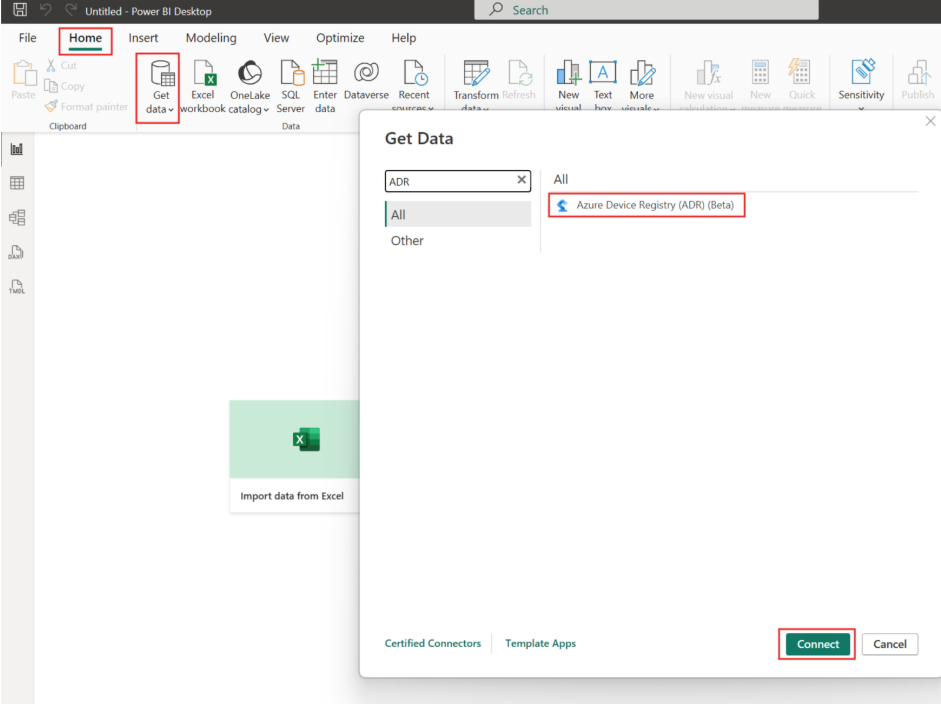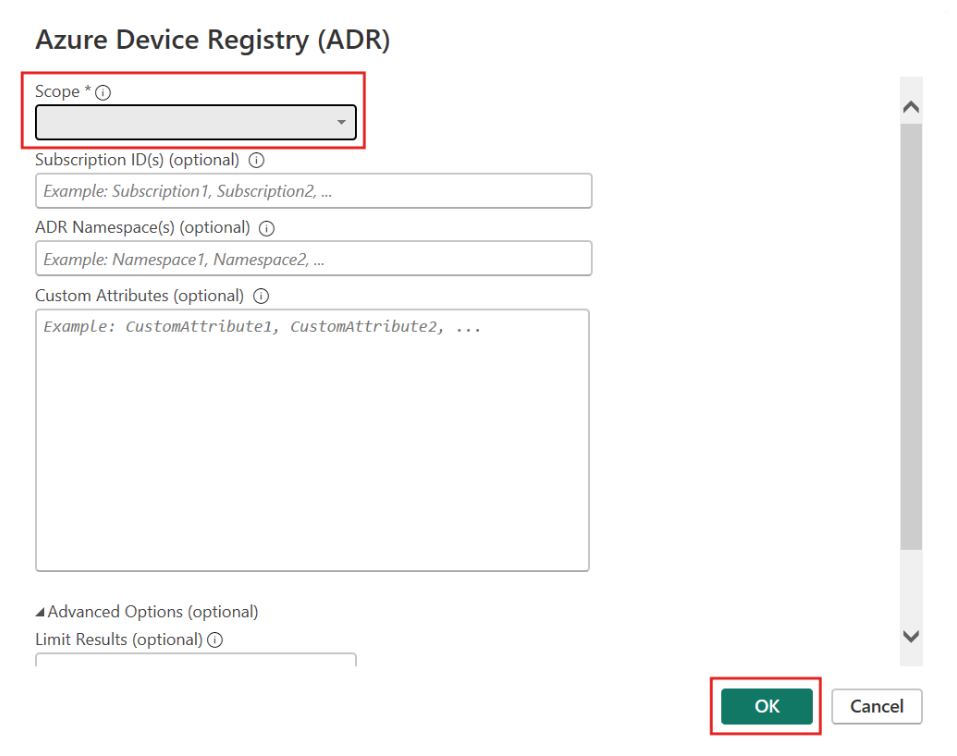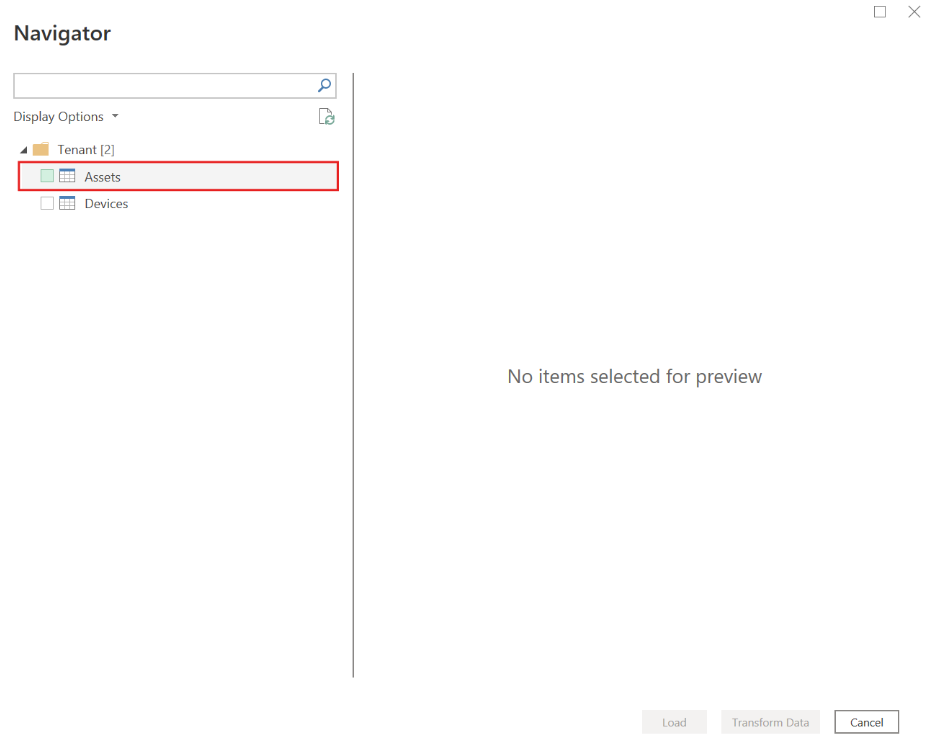Note
Access to this page requires authorization. You can try signing in or changing directories.
Access to this page requires authorization. You can try changing directories.
Summary
| Item | Description |
|---|---|
| Release State | Preview |
| Products | Power BI (Semantic models) Power BI (Dataflows) Fabric (Dataflow Gen2) |
| Authentication Types Supported | Organizational Account |
Note
Some capabilities might be present in one product but not others due to deployment schedules and host-specific capabilities.
Prerequisites
- An Azure subscription. Go to Get Azure free trial.
- You must have appropriate rights in Azure role-based access control (Azure RBAC) with at least read access to the Azure Device Registry resources you want to query.
Note
The Azure Device Registry connector only works for namespace assets (preview) and namespace devices (preview) in AIO 1.2.x versions. For more information, see What is asset and device management in Azure IoT Operations?.
Capabilities supported
- Import
- Scope by tenant or subscription(s)
- Filter subscription(s) by ADR namespace(s)
- Define/specify custom attributes
- Advanced options
- Limit results
- Maximum rows per page
Connect to Azure Device Registry from Power Query Desktop
To connect to Azure Device Registry from Power Query Desktop:
In Home > Get Data, search for Azure Device Registry or ADR, and then select Azure Device Registry. For more information, see Where to get data in Power Query.

In the Azure Device Registry dialog, select a scope, either Tenant or Subscription(s), and fill in any optional or advanced fields.

Field Description Scope Choose whether to retrieve data from all Azure subscriptions in your tenant or from specific subscriptions. Subscription ID(s) Applies only when scope is set to Subscription. By default, all subscriptions are included. Enter one or more Subscription IDs, separated by commas, to narrow the scope to specific subscriptions. If you select tenant for scope, you don't need to add a Subscription ID. ADR Namespace(s) Applies only when scope is set to Subscription. By default, the namespace filter applies across all subscriptions if no Subscription IDs are provided. Enter one or more ADR namespaces, separated by commas, to filter results. If you select tenant for scope, then you don't need to add an ADR Namespace. Custom Attributes Enter a comma-separated list of up to 100 custom attribute names to include as separate columns. A column named "attributes" is always included and contains all custom attributes in JSON format, even if they aren't listed in this field. Note
Results are limited to 100 records by default. To change this setting, set the Limit Results advanced option to FALSE.
Select Next.
If you're connecting to this site for the first time, select Sign in and input your credentials. Then select Connect.
In Navigator pane, select the tables with the resource types you require. You can select either namespace assets (preview), devices (preview), or both.

Select Load or Transform Data to proceed.
Connect to Azure Device Registry from Power Query Online
To connect to Azure Device Registry from Power Query Online:
In Choose data source, select Azure or search for Azure Device Registry, and then select Azure Device Registry. For more information, see Where to get data in Power Query.
In Connect to data source, select a scope and fill in any optional or advanced fields.
Note
You can scope your data to either tenant or subscription level. If neither option is chosen, the connector executes at the tenant level by default.
Field Description Scope Choose whether to retrieve data from all Azure subscriptions in your tenant or from specific subscriptions. Subscription ID(s) Applies only when scope is set to Subscription. By default, all subscriptions are included. Enter one or more Subscription IDs, separated by commas, to narrow the scope to specific subscriptions. ADR Namespace(s) Applies only when scope is set to Subscription. By default, the namespace filter applies across all subscriptions if no Subscription IDs are provided. Enter one or more ADR namespaces, separated by commas, to filter results. Custom Attributes Enter a comma-separated list of up to 100 custom attribute names to include as separate columns. A column named "attributes" is always included and contains all custom attributes in JSON format, even if they aren't listed in this field. Select Next.
If you're connecting to this site for the first time, select Sign in and input your credentials. Then select Connect.
When you're successfully signed in, select Next.
In Choose data, select the resource types you require (either namespace assets (preview), devices (preview) or both) and then select Create.
Note
Expect longer wait times for large query results.
Connect using advanced options
Power Query provides advanced options that you can add to your connector if needed.
| Advanced option | Description |
|---|---|
| Maximum Rows per Page | Set the maximum number of rows per API call. The default is 500. You can increase this to improve performance, but larger values might increase response size. |
| Limit Results | By default, all available records are returned. Set to true to limit the results to the first 100 records. |
